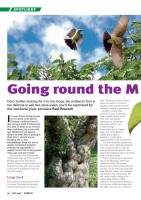Special Offers
Redeem Offer Code
Redeem Gift Voucher
Scarecrow Members
Our Feedback
Just wanted to let you know that I have tried your Stop Gro G8 . It seems to have done the trick, will certainly recommend you to all my friends.Looking forward to placing orders for plants ...many thanks.
S McGill Edinburgh
sandra mcgill, EDINBURGH

Going Round The Mulberry Bush
le 'Going Round The Mulberry Bush'" width="213" height="300" />Don’t bother looking for it in the shops, the mulberry fruit is too delicate to sell but, once eaten, you’ll be captivated by this wonderful plant, promises Paul Peacock
It’s one of those things you do for the good of the planet. Planting a mulberry tree is like having a child; it will outlive you, take 10 years or so to settle down and bring joy to your old age. Mulberries are special, there’s no other way of putting it. They have a natural way of bringing life to their surroundings. Sadly the tree is almost overlooked, possibly because it’s impossible to exploit. Its fruit fall to the ground when ripe and don’t travel.
The mulberry is a Chinese tree that became popular in the west for feeding silkworms. King James planted a field of black mulberries at Greenwich in the 17th century, only to discover that silkworms only ate the white variety
Long-Lived
The mulberry looks old even when it’s young. The branches become gnarled and twisted and droop a little. The black mulberry, Morus nigra, can live for a couple of hundred years, but the majority last only a couple of generations – enough to outlive their planters for sure. It has large heart-shaped leaves, bears pink male and female flowers in the late spring and early summer, and produces large, flavoursome fruit in August. Every part of the plant is edible and is used in medicine – particularly against tetanus in the Third World.
The fruits resemble raspberries, but have a more wholesome flavour and, as soon as they’re ripe, the berries fall from the tree. For this reason the traditional way to grow the plant is in short grass.
There are three types usually for sale in the UK; black, white and pendulous white. The names describe the colour of the buds, not the fruit. It’s the black that bears the best fruit and, unless you wanted to experiment with making your own silk, there’s really nothing to be gained from buying a white mulberry. The pendulous white has fruit that are a little less sharp than the white, and also has a weeping habit, making it more suitable for smaller gardens.
If allowed to, the black mulberry will grow to 50 feet or more, so make sure you account for this in your planning. To counter this, it will do so very slowly, taking a couple of decades to reach a decent height. There are only a few cultivars of the black mulberry, ‘Chelsea’ being the most popular.
Interestingly, mulberries seem to have a unique defence against fungi, although this hasn’t been fully researched. They don’t appear to succumb to fungal diseases when mature, and mushrooms won’t grow close to them. Some people grow grape vines around mulberries to avoid fungal disease, like botrytis, appearing on the grapes, and this seems to work.
Planting
The traditional way to plant a mulberry is to thrust a piece of sawn-off trunk into the soil. It seems a little haphazard, but all the ancient mulberries have been grown in this way. However, these days you can buy young trees that are ready for planting.
In the south they grow well but they’ll need a little more shelter in the north. Dig a good-sized hole; twice the size of the root ball, making sure the site is well drained. Infill the plant with a rich mixture (50:50) of good soil and well-rotted, high quality compost. Give it a good watering and feed regularly for the first few years.
Be careful with the roots, which can be quite brittle and break easily. Once set in place, the tree should be staked to minimise stress on the roots.
Don’t expect great amounts of fruit to begin with. Like a baby, this tree needs some cosseting to help build up its immune systems. In the autumn give the plant a good mulch of leaf mould and compost, and protect it from harsh, wet or icy winds.
Once the first frosts appear the plant quickly loses its leaves and becomes heavily dormant. Around a month after leaf fall you can prune it. Take out only wood that’s growing inconveniently, or that appears to be dead. It doesn’t need any further pruning and don’t prune when the plant is in leaf; it’s almost impossible to stop the sap flowing.
By its 10th birthday the tree should be doing well. All being well, it’ll develop to become majestic in stature, very handsome and a spectacular addition to the garden.
This article first appeared in the July 2007 of Grow It magazine. To download a pdf copy of the original article click on the image below...
Black Mulberry Tree

Purplish-black, sweet and juicy fruits mid Summer. A real treat that is never seen in supermarkets. A highly ornamental tree in its own right. Self Fertile.
Available Now
Supplied as a pot grown tree approximately 2- 3 feet (60 - 90 cm) tall including pot.
White Mulberry Tree

The favourite food source for silk moths. Slightly sharp finish to the fruit, even when ripe. Self Fertile.
Available Now
Supplied as a containerised tree pruned to approximately 3-4 ft (90-120cm) tall including pot.

 01233 740529
01233 740529


